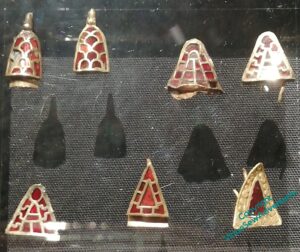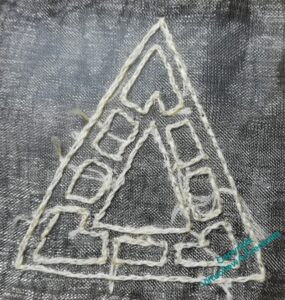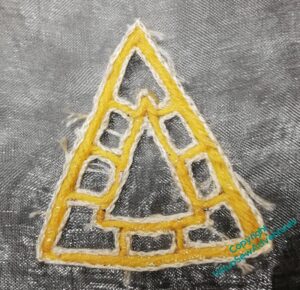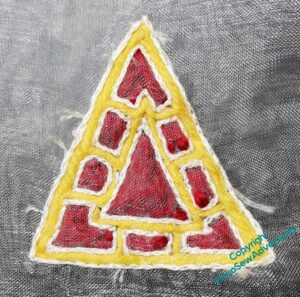An Experiment For Aethelflaed
I’m beginning to realise that if I take into account at the beginning of a project the final destination of it or the way it’s going to be displayed, life might be a bit easier.
I think the Medieval Movers and Shakers may end up displayed on banners, but while the clerics Rahere and Dame Julian should probably be on a simple vertical drop, like a pulpit fall, I think William and Aethelflaed might want somethiing more ornate.
With that in mind, one idea I had for Aethelflaed was to ornament her banner with reproductions of Anglo Saxon jewels in trapunto quilting. Easier said than done, and I don’t imagine I’ll get it right first time, so I hope that this will give me some thoughts!
Trapunto involves creating channels and cells that can then be filled with coloured yarns or wool. This experiment is done using leftover gauze from the Amarna overlays, and the design was quite roughly hand-drawn to make a first approximation, but in due course I had all the lines done in split stitch.
Then it was time to fill in the channels and cells. Mindful of my recent experience with the Golden Accessories, when I found there was definitely a Right Order in which to fill in the strapwork, I did (believe it or not!) pause for thought before just barrelling in. I think I made the right choice – the channels are quite narrow, and it was definitely easier to fill them in first. I’ve used tapestry wool, and I’m not sure that’s necessarily the best choice, but it’s the right sort of colour, and with the narrow channels, it’s easier than fleece. Especially as I don’t have any to hand!
The final stage was to fill in the cells – this time with Paternayan. I think I would prefer to use fleece for cells, to avoid having shadow lines between the “stitches”, but as a first attempt, I think it’s worked well.
Two layers of gauze are a bit much, though, I think it would be easier to manage if the backing were in calico. So next time I have a moment for this sort of experimentation, I might start with that, and maybe a different shade of gauze.





It’s definitely worked though, even if you do find you want to refine the finer details. Well done!!
I just love that style of garnet jewelly and your experiment has worked well.
That’s heading in the right direction. Don’t forget that you can always turn yarn back to a sort of fleece for the larger areas, simply with a bit of unravelling and an attach with a wire brush.
How about looking at slightly metallised gauze for your top fabric? (Evening dress or Indian fabric?) What about the colour of a more solid backing fabric? And the channel stitches. Dark, light? You will have lots of fun experimenting.
Have you thought about using Boutis cotton for raising the Trapunto work? Both techniques are very similar and you might find the Boutis cotton easier to work with.
Looks good to me – I would have started with the yellow first though my reasoning is a bait different – I simply prefer doing whatever colour takes up the largest area first… not sure why, but it’s always what I do.